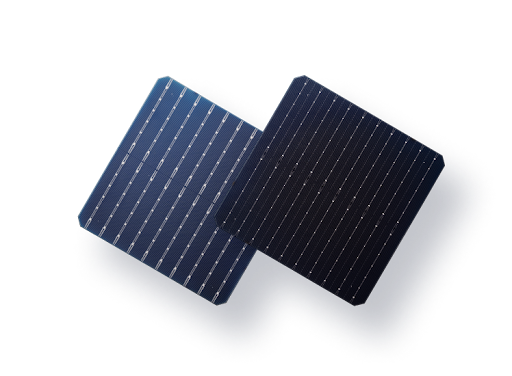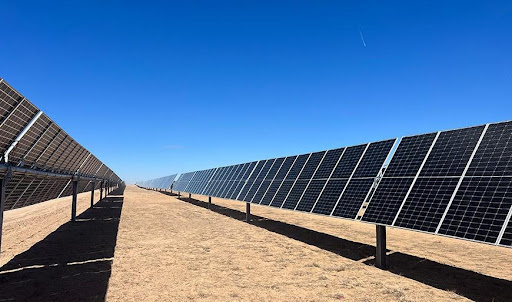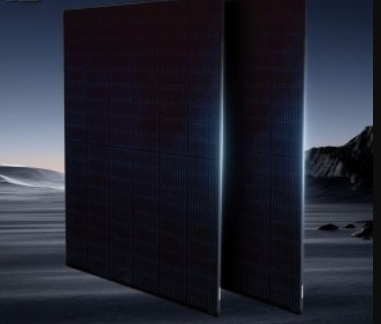Property owners have had to make tough choices when going solar for years. While standard blue photovoltaic panels are exceptional at converting sunlight into renewable electricity, their vibrant azure hue tends to clash with most residential and commercial architecture.
With black solar panels, there’s no longer any need to choose between sustainability and preserving your property’s aesthetic appeal. In this blog, we’ll explore the key factors driving this emerging solar trend.

Why are Most Solar Panels Blue or Black?
At their core, solar panels rely on silicon-based semiconductor materials to convert sunlight into usable direct current (DC) electricity to power your property. Photons emitted from the sun’s rays dislodge electrons in the semiconductor material, allowing that current to flow.
So, what gives solar panels their distinctive blue or black shading? The silicon cells are naturally black or dark in color due to the material’s ability to absorb photons from sunlight. The color of solar panels then comes down to the specific semiconductor coatings and materials being used:
Blue silicon solar cells, usually made of polycrystalline solar cells, feature a thin anti-reflective coating designed to reduce light deflection and enhance photon absorption for maximum efficiency. While boosting output, this coating treatment leaves solar panels with a signature bright blue outer appearance.
Black silicon solar cells are often made of monocrystalline cells, which gives the panels a more uniform appearance and a darker color with the help of their ability to absorb more wavelengths across the entire solar spectrum. Sometimes, a black back sheet and frame are added to enhance the characteristic integral midnight hues and give us the all-black solar panels.
Is Black Solar Panel Better Than Blue Solar Panel?
Like conventional blue options, black-on-black solar panels prioritize energy generation first and foremost. But when you examine the granular performance data, it’s apparent black alternatives offer more output potential while staying visually discreet:
Higher Peak Efficiency Ratings
You’ll find high-efficiency models across both black and blue solar panel varieties. However, as a general rule, black options see higher conversation efficiency. The monocrystalline cells, commonly found in black solar panels, can convert 1-2% more sunlight into electricity compared to the blue (typically polycrystalline) ones.
Performance in low-light situations
Black solar panels, mainly crafted from high-purity monocrystalline silicon, excel in low-light conditions. The higher purity and more orderly structure allow for better electron mobility and less resistance, which can contribute to better performance even in less intense light conditions.
Heat Tolerance
Monocrystalline solar panels excel in heat resistance due to their cell technology and manufacturing process. It is an all-in-one single-crystal piece created with high-purity silicon. This means there’s less resistance when electrons move around, which helps ensure the desirable performance even in high temperatures.
Space Efficiency
Thanks to higher efficiency and power output, you can achieve the same amount of electricity with fewer black solar panels, making them ideal for installations with limited roof or ground space.
Longer Lifespan
Black solar panels typically have a longer lifespan than blue panels due to their use of high-quality materials and advanced manufacturing processes, providing reliable and sustainable energy production for years to come.
Cost
Monocrystalline panels or modules carry a hefty price tag due to their energy-intensive and demanding manufacturing process, with only a 50% yield for every silicon crystal. As a result, black solar panels are more expensive than their blue counterparts, with a 25% to 50% premium on price.
To sum up, black solar panels, in general, are better than blue solar panels with higher conversion efficiency, better performance in low light situations, better heat tolerance, space efficiency, and longevity. But beware, the specific performance can vary based on the manufacturing process, the quality of materials used, and the specific conditions in which the panels are installed and operated.

What are the Different Types of Black Solar Panels?
All-Black Solar Panels
Conventional panels typically feature white back sheets and silver frames, whereas all-black modules opt for black back sheets and frames. All-black modules are more aesthetically pleasing, but their efficiencies can be slightly lower (0.5%, to be specific, than white backsheet panels).
Black Solar Panels with White Backing or White Frame
Black solar panels with white backing or white frames offer a stylish alternative to traditional panels. They combine modern mono-panel black design with slightly higher efficiency compared to all-black panels, thanks to the reflective properties of the white elements.
Black Bifacial Solar Panels
Bifacial panels utilize both semiconductor surfaces to absorb direct and reflected/diffused light simultaneously. The black bifacial solar panels integrate sleek aesthetics with the maximum possible output, especially in locations with high sunlight reflection.
However, to maximize the value of black bifacial solar panels, one should partner with experienced dealers and installation teams for careful planning and consideration, as the choice of mounting structure, ground surface, or roofing material can significantly impact their performance.
For more information on different types of black solar panels, you can go to our product manual on solar modules.
How to Choose the Black Solar Panels?
Once you’ve fully comprehended the advantages of black solar panels in performance and aesthetics, it’s time to start browsing and choosing. Whether for new construction or a retrofit, a few key considerations will help determine the optimal black panel solution for your residential, commercial, or utility property:
- Calculate Energy Requirements: What are your property’s monthly/annual electricity consumption averages? This will allow you to size your system appropriately in terms of combined solar output capacity (rated wattage) across all panels.
- Assess The Installation Environments: Opt for black bifacial panels in high sunlight reflection areas like snowy or sandy locations. Prioritize aesthetics with all-black panels. Otherwise, choose black panels with white backing or frame for a balance between efficiency and cost.
- Evaluate Reputable Manufacturers: As with any significant energy investment, it’s critical to source black solar panels only from brands with proven track records of reliability, customer satisfaction, and solid warranty policies.
- Review Efficiency and Temperature Specs: Overall solar conversion efficiency percentages provide a good baseline. However, temperature coefficient values should also be examined to determine how local climate patterns may impact performance.
- Account for Site Requirements: Analyze prospective solutions to ensure specific panel dimensions, weight limits, wind/fire resistance ratings, and total system output align with your local building codes and property characteristics.
The Ultimate Black Solar Energy Solution
This new EliTe Solar All-Black 182-54 N-Type Bifacial Module represents the total package by fusing discrete all-black aesthetics with cutting-edge bifacial technologies. Its features include:

- Industry-leading 22.0% solar conversion efficiency from ultra-pure N-type photovoltaic cells with passivated contacts.
- Bifacial, dual-sided design generates power from direct sunlight on one surface and reflected/ambient rays on the opposite side for up to 30% higher energy yields.
- Superior resistance to light-induced degradation compared to older silicon cells for consistently high output over time.
- Ultra low-profile grid lines and darkened frames blend seamlessly into surrounding roof materials.
As a global leader in the industry, EliTe operates with vast capacities across facilities in Vietnam and Cambodia, delivering optimized solar solutions worldwide. Its commitment to excellence is recognized through various awards.
References
[1] Energy Matters/2023. Available at https://www.energymatters.com.au/renewable-news/black-vs-blue-solar-panels-whats-the-difference/. (Accessed on April 22nd, 2024)
[2] Olaoluwa John Adeleke. 2023. Comprehensive Guide to Solar Panel Types. Available at https://www.researchgate.net/publication/372909989_Comprehensive_Guide_to_Solar_Panel_Types. (Accessed on April 22nd, 2024)
[3] Green Match/2024. Black Solar Panels in the UK: Costs + Pros & Cons in 2024. Available at https://www.greenmatch.co.uk/solar-energy/solar-panels/black. (Accessed on April 22nd, 2024)
